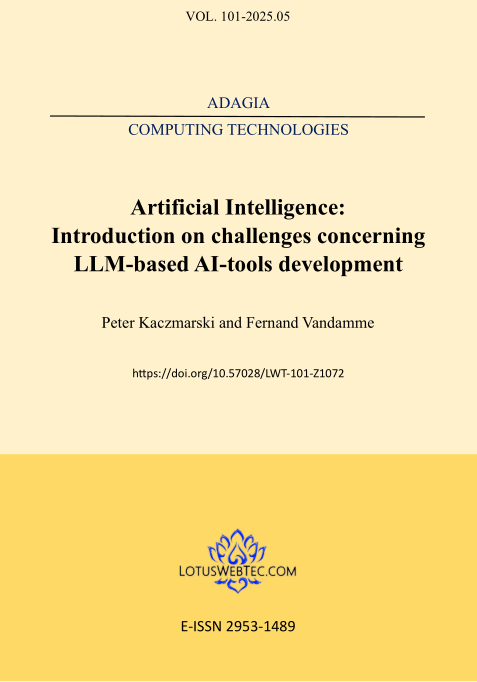ADAGIA 101-2025.05
Artificial Intelligence: Introduction on challenges concerning LLM-based AI-tools development
Peter Kaczmarski and Fernand Vandamme
https://doi.org/10.57028/LWT-101-Z1072
 Pages: 104 E-ISSN: 2953-1489 Order form |
Book Summary In recent years there have been many breakthroughs in various areas of Artificial Intelligence computing technologies, mainly with respect to building general GPTs (Generative Pre-Trained Transformers), and their extensions. This book takes a snapshot of today’s state-of-the-art in the main areas of these developments from the perspective of available AI capabilities and their possible utilization in custom cloud-based AI- tools. In the first two parts, attention is given to online accessibility of the top-ranked Large Language Models (LLMs) from Anthropic, Google, and OpenAI, and to the assessment of their available capabilities such as streaming chat, Theory of Mind tests analysis, reasoning on images, and LLM-based information retrieval using RAG, while the third part highlights the path from creating a custom local AI-tool to its cloud deployment and further to its online use. On a more general level, the presented insights and code snippets form a reference for building more extensive Artificial Intelligence use cases using Python and/or .NET 8 (LTS) |
Table of contents
| About this book | 4 |
| 1 LLM-based AI-tools: case studies | 8 |
| 1.1 Introduction | 8 |
| 1.2 LLM-based AI-tools for knowledge assistance | 10 |
| 1.3 Adapting the answering style of LLMs | 14 |
| 1.4 LLM-based scenario analysis and Theory of Mind 17 | 17 |
| 1.5 Document summarisation | 19 |
| 1.6 Advanced use cases for LLMs | 21 |
| 1.7 Conclusions | 29 |
| 1.8 Appendix A: Developing LLM chat clients in Python | 30 |
| 1.9 Appendix B: Chat test results overview | 34 |
| 1.10 Appendix C: Theory of Mind test | 40 |
| 1.11 Appendix D: Document summarisation tests | 42 |
| 1.12 References | 48 |
| 2 LLM-based text search using RAG: implementation and assessment | 52 |
| 2.1 Introduction | 52 |
| 2.2 RAG procedure summary | 53 |
| 2.3 Implementation overview | 54 |
| 2.4 Experimental results | 56 |
| 2.5 Discussion of limitations and challenges | 59 |
| 2.6 Conclusions | 60 |
| 2.7 Appendix A: Python RAG implementation | 61 |
| 2.8 Appendix B: Test document contents | 64 |
| 2.9 References | 69 |
| 3 Building LLM-based AI-tools for the cloud | 72 |
| 3.1 Introduction | 72 |
| 3.2 Implementing a Blazor OpenAI LLM Chat in C# | 73 |
| 3.2.1 Initial Blazor project | 73 |
| 3.2.2 Adding a Razor chat component | 74 |
| 3.2.3 Implementation of the LLM chat functionality | 76 |
| 3.2.4 Testing the chat function in debug mode | 81 |
| 3.3 Deploying the chat application to Google Cloud Platform | 83 |
| 3.3.1 Publishing a release version of the web application | 83 |
| 3.3.2 Docker image creation | 85 |
| 3.3.3 Importing Docker image to Google Artifact Registry | 86 |
| 3.3.4 Securing the OpenAI API key in GCP Secret Manager | 88 |
| 3.3.5 Deploying Docker image from GAR to GCP Cloud Run | 89 |
| 3.4 User experience: a simple test | 91 |
| 3.5 Conclusions | 94 |
| 3.6 Appendix A: Code listing (llmchat.razor) | 95 |
| 3.7 References | 98 |
| 4 Summary | 102 |
| About the authors | 104 |


